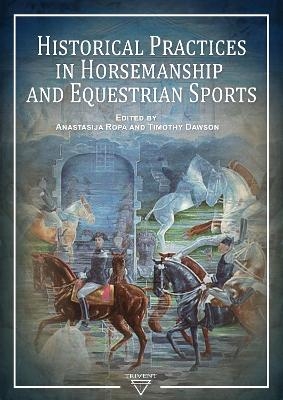
Historical Practices in Horsemanship and Equestrian Sports
Trivent Medieval (Verlag)
978-615-6405-61-6 (ISBN)
- Titel nicht im Sortiment
- Artikel merken
New things are forgotten old things – this rediscovery of the past is especially important in horsemanship and equestrian sports. Despite advances in sciences and technology, the physiologies and psychologies of the two principal agents, the equid and the human, have undergone relatively few changes since horse domestication.
The studies collected in this volume outline such essential and recurring challenges in equestrianism as gender issues, equine identification, the use of hyperflexion and groundwork in training, as well as many others, from prehistory to this day.
Anastasija Ropa holds a doctoral degree from Bangor University (North Wales) and is currently a senior researcher at the Latvian Academy of Sport Education. Her most recent research explores medieval equestrianism in English and French literary sources. Timothy Dawson, PhD (2003), University of New England, is a UK-based independent scholar and founder of Levantia. He has authored numerous academic publications on medieval Byzantium, the history of horsemanship and cavalry and various aspects of daily life in Europe and the Near East.
Foreword — Jason Kingsley
Introduction. Continuities of Equestrian Practices — Anastasija Ropa
CHAPTER 1: Envisioning Early Equestrianism: Clues from Archaeology and Ancient DNA — Katherine S. Kanne
CHAPTER 2: Feminizing the Hippodrome: Finding the Female in a Male World — Carolyn Willekes
CHAPTER 3: The Horses of the Bayeux Tapestry: Where the Art of Roman Riding Meets the Middle — Ages Anneli Sundkvist
CHAPTER 4: Appraising the Warhorse: Restaurum Equorum in the Reigns of Edward I and II — Emma Herbert-Davies
CHAPTER 5: Horse Head Position in Premodern Times: A Textual, Iconographic, and Archeological Analysis — Jennifer Jobst
CHAPTER 6: Groundwork with Horses: Learning from Medieval and Early Modern Treatises — Anastasija Ropa
CHAPTER 7: The Italian Influence on Equestrian Art in Europe in the Sixteenth and Seventeenth Centuries — Marcin Ruda
CHAPTER 8: An Experimental Case Study of Pluvinel's Horse Training around the Single Pillar — Lisa Marieke Kyre
CHAPTER 9: Playing Chicken: The Early History and Modern Revival of an Ancient Game — Jane Badger & Timothy George Dawson
CHAPTER 10: Fox-hunting and Classical Horsemanship as Social Performance of Elitism and Power: A Journey Across Time — Sarah Sargent
CHAPTER 11: Retrospective: Michel Henriquet on the Vanishing Point of Lightness — Kip Mistral
List of Contributors
| Erscheinungsdatum | 31.01.2023 |
|---|---|
| Reihe/Serie | Rewriting Equestrian History |
| Zusatzinfo | 42 illustrations |
| Sprache | englisch |
| Maße | 148 x 210 mm |
| Gewicht | 272 g |
| Themenwelt | Sachbuch/Ratgeber ► Natur / Technik ► Tiere / Tierhaltung |
| Geschichte ► Teilgebiete der Geschichte ► Kulturgeschichte | |
| Sozialwissenschaften ► Soziologie | |
| ISBN-10 | 615-6405-61-5 / 6156405615 |
| ISBN-13 | 978-615-6405-61-6 / 9786156405616 |
| Zustand | Neuware |
| Haben Sie eine Frage zum Produkt? |
aus dem Bereich


